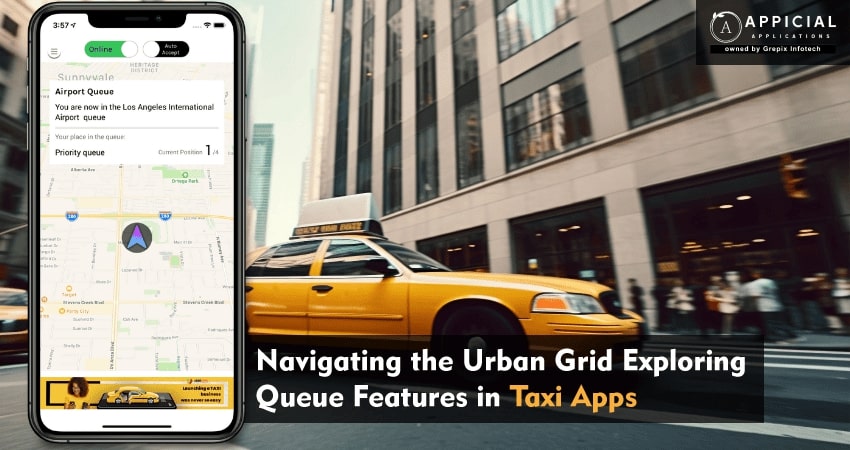
Navigating the Urban Grid: Exploring Queue Features in Taxi Apps
In the ever-evolving landscape of urban transportation, taxi apps have not only revolutionized the way we hail rides but have also introduced sophisticated queue features to optimize the efficiency of the entire process. These queue features play a pivotal role in ensuring a seamless experience for both drivers and passengers. In this blog, we'll take a closer look at the diverse queue features found in taxi apps, each designed to address specific challenges in urban mobility.
Airport Queue Management: Ensuring Order in the Chaos
Airports are bustling hubs of activity, and managing the flow of taxis is crucial for a seamless travel experience. Taxi apps with airport queue features enable drivers to join a virtual queue, ensuring fairness in picking up passengers. This not only prevents chaos but also optimizes the utilization of drivers.
Uber makes sure you select the ideal car for your needs, regardless of your preferences for affordability, comfort, or style. Before booking an Uber ride, you can receive an estimate of the cost upfront. As a result, you will always know how much your trip will cost before you place your order. You can call local authorities directly and share your location with anyone using the app.
Dive into the world of queue features in taxi apps and discover how they enhance the overall user experience. This blog post explores the importance of queue management in ride-hailing services, offering insights for both app operators and users. Whether you're a developer looking to improve your app or a rider curious about the behind-the-scenes functionality, this guide provides valuable information on the role of queue features in taxi apps.
First-Come-First-Serve Basis: Fairness in Action
One of the fundamental principles behind queue features is the "first-come-first-serve" basis. This ensures that drivers who have been waiting the longest get the first opportunity to pick up passengers, promoting fairness and equity among drivers.
Geofencing Technology: Precision in Location-Based Queues
Many taxi apps leverage geofencing technology to create virtual queues around specific locations, such as airports or busy pick-up areas. This precise location-based queuing system ensures that drivers are in the right place at the right time, reducing wait times for both drivers and passengers.
Queue Notifications: Keeping Drivers Informed
To keep drivers informed and engaged, taxi apps often send real-time notifications about their position in the queue and estimated wait times. This feature empowers drivers to make informed decisions about their time and helps them plan accordingly.
Priority Queues: Catering to Specific Needs
Some taxi apps introduce priority queues for certain categories of drivers, such as those using electric vehicles or high-rated drivers. This not only promotes sustainability but also recognizes and rewards drivers who excel in service quality.
Pre-Booking Options: Minimizing Airport Wait Times
To further enhance the airport experience, some taxi apps allow passengers to pre-book rides, reducing the time spent waiting in queues. This feature is particularly beneficial for travelers who prioritize efficiency and want to minimize wait times after a long flight.
Dynamic Queue Adjustments: Adapting to Demand
Smart algorithms in taxi app analyze demand patterns and dynamically adjust queue lengths. This ensures that the number of drivers in the queue aligns with passenger demand, preventing excessive waiting times during peak hours.
Queue Analytics: Data-Driven Optimization
To continually improve the queue experience, taxi apps often employ analytics tools to gather data on queue performance. This data-driven approach helps identify trends, optimize queue management strategies, and enhance overall service efficiency.
Different types of Queues
1. Airport Queue
Although so many drivers choose to begin their days at airports, they can get quite crowded. An improved system will delay the time a trip request is processed by the driver at the airport. The "first come, first served model" is how it operates. As a result, the driver receives trips on time, which benefits both drivers and passengers. However, at the airport, a clear method of allocating trips is predicated on a queue system.
2. Railway Station Queue
The taxi queue at a railway station serves as a vital link in the transportation network, seamlessly connecting train travelers with their final destinations. Positioned strategically outside the station, this queue provides a structured and organized system for passengers to secure a taxi promptly upon their arrival. Railway station taxi queues are designed to manage the flow of both passengers and vehicles efficiently.The proximity to the station ensures that travelers can transition seamlessly from trains to taxis, enhancing the overall convenience of their journey. This queue system is particularly valuable during peak hours or when large numbers of passengers disembark simultaneously, preventing chaos and enabling a smooth and orderly process for securing transportation. With clear signage, designated waiting areas, and often integrated with modern ride-hailing apps, railway station taxi queues contribute significantly to the accessibility and connectivity of public transportation systems.
3. Mall Queue
The introduction of a mall queue taxi feature has revolutionized the transportation experience for shoppers, offering a seamless and efficient solution to the perennial challenge of securing a taxi during peak hours. This innovative feature allows mall-goers to join a virtual queue for taxis, eliminating the need to wait in long and chaotic lines. The convenience is two-fold, as users can remotely request a taxi through a dedicated app, specifying their pick-up location within the mall premises. This not only reduces the stress of hailing a cab in a crowded area but also ensures a fair and organized system for taxi access. The mall queue taxi feature leverages technology to optimize the transportation process, enhancing the overall shopping experience by saving time and providing a more comfortable and predictable commute for visitors. As urban spaces continue to evolve with smart solutions, this feature stands as a testament to the positive impact technology can have on simplifying everyday tasks and improving the efficiency of public services.
4. Bus Stand Queue
The integration of a bus stand queue taxi feature marks a significant advancement in urban transportation, particularly for commuters relying on public transit. This innovative system streamlines the process of securing a taxi for those disembarking from buses, alleviating the common struggles associated with finding a taxi in bustling areas. Travelers can now conveniently join a virtual queue through a dedicated app, specifying their location at the bus stand and awaiting their turn for a taxi pick-up. This technology-driven solution not only enhances the overall efficiency of the transportation network but also fosters a more organized and fair approach to accessing taxis. By leveraging the synergy between public transit and taxi services, this feature contributes to a seamless and interconnected urban mobility experience. It exemplifies how technological advancements can be harnessed to simplify daily commuting challenges, making transportation more accessible and user-friendly for individuals relying on a combination of bus and taxi services.
Conclusion
In conclusion, the incorporation of taxi queue features in app development has undeniably transformed the urban transportation landscape, providing users with a more organized, efficient, and convenient way to access taxi services. The seamless integration of virtual queues at places like malls or bus stands not only streamlines the process of hailing a taxi but also contributes to a more orderly and fair system for both passengers and drivers.
As the world embraces smart solutions and technology continues to reshape urban experiences, these queue features represent a significant step forward in enhancing the overall efficiency and accessibility of taxi services. By prioritizing user convenience and leveraging digital advancements, taxi app developers have successfully navigated the challenges of urban mobility, offering a glimpse into a future where transportation is not only reliable but also seamlessly integrated into the fabric of our daily lives. The evolution of taxi apps with queue features signifies a positive shift towards a more connected and user-centric urban transportation ecosystem.
Get in touch with Appicial Applications right now if you want to create a taxi booking solution and rule the market! As proficient experts, we always meet or exceed our clients' expectations.
Looking out to start your own venture like Uber? Try out our HireMe Taxi Uber Clone, the easiest way to kick-start your taxi business.





